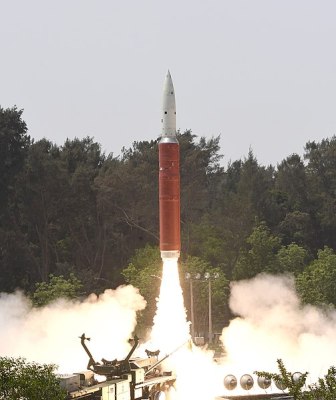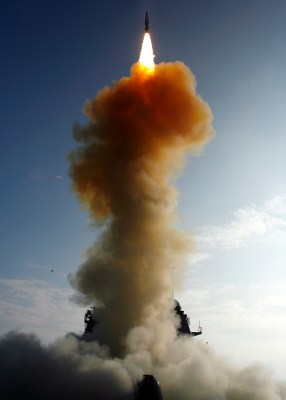Russian Anti-Satellite Weapon Test Draws Widespread Condemnation

On the morning of November 15, a Russian missile destroyed a satellite in orbit above Earth. The successful test of the anti-satellite weapon has infuriated many in the space industry, put astronauts and cosmonauts alike at risk, and caught the attention of virtually every public and private space organisation on the planet.
It’s yet another chapter in the controversial history of military anti-satellite operations, and one with important implications for future space missions. Let’s examine what happened, and explore the greater context of the operation.
Analysis from several sources indicates that an anti-satellite weapons system destroyed a Russian satellite designated COSMOS 1408. The satellite served in an electronic and signals intelligence role for the Soviet Union, and was launched in 1982 with an expected mission life of six months. The 2,200 kg satellite had been defunct for decades, and was sitting in Low Earth Orbit at an altitude of approximately 480 km.
US Space Command have since released a statement, indicating that Russia fired a direct-ascent anti-satellite missile which struck COSMOS 1408. The findings were independently verified by a number of private-sector space organisations, including LeoLabs and Seradata.
Exact details are hard to come by, but suspicions centre around the use of the Russian PL-19 Nudol missile for the test. The PL-19 is a ground-launched missile which has been seen in testing as recently as last year, and has anti-ballistic missile applications in addition to the anti-satellite role. The two missions share similar requirements – the need for a missile with high delta-V and high maneuverability in order to hit fast-moving targets at orbital altitudes. It’s not Russia’s only recent anti-satellite project, either, with the country reportedly recently testing a satellite designed to kinetically attack other satellites in orbit.
YouTube video: Data captured by LeoLabs indicates the debris field from the anti-satellite weapon test passing near to the orbit of the International Space Station (ISS).
The test quickly drew widespread condemnation from much of the space community. Perhaps most notably, according to a statement from NASA. astronauts and cosmonauts aboard the ISS were instructed to shelter in place. The team onboard donned their spacesuits, closed hatches to some radial ISS modules, and boarded the SpaceX Crew Dragon currently docked with the space station. These measures were taken for the first few passes through the debris field generated by the test, before NASA deemed the situation safe. As reported by multiple sources, hatches between the US and Russian parts of the space station remain open. Notably, two of the seven people aboard the space station are Russian cosmonauts, who were also placed at risk by the Russian test.
NASA administrator Bill Nelson expressed anger with a statement noting that he was “outraged by this irresponsible and destabilizing action. With its long and storied history in human spaceflight, it is unthinkable that Russia would endanger not only the American and international partner astronauts on the ISS, but also their own cosmonauts. Their actions are reckless and dangerous, threatening as well the Chinese space station.”
The problem with such testing is the huge amount of debris generated, which places other spacecraft at risk from damage or destruction. Reports from US Space Command indicate that the test generated over 1500 trackable pieces of debris, and likely “hundreds of thousands” of smaller pieces of debris that are too small to be monitored with current technology.
Present estimates indicate that the debris could remain in orbit for years, if not decades, threatening spacecraft in a wide orbital region that’s heavily used by existing spacecraft. The ISS orbits generally around 300 km – 400 km, and took aforementioned precautions around the debris field. SpaceX Starlink satellites orbit around 550 km, incidentally, a low orbit chosen so that they’ll deorbit and burn up after their service life is over to avoid adding to the problem of space junk in LEO. The Hubble Space Telescope orbits at 540 km, and the Chinese space station Tiangong similarly orbits between 340-450 km.

A similar test by India in 2019 drew ire as well, though by virtue of occurring at a lower altitude and with less political context, perhaps was not quite as poorly received as today’s Russian test. Current modelling suggests that most of the fragments from the Indian test, which destroyed the Microsat-R satellite at an altitude of 270 km, would deorbit relatively quickly, within the next few years.
Conversely, a Chinese test in 2007 targeted the FY-1C weather satellite at a much higher altitude of 865 km, leaving debris in a much higher orbit. Over half of the debris from the test still orbits above 850 km, and is expected to remain in orbit for decades or centuries to come. In 2011, a piece of the destroyed satellite passed within six kilometers of the ISS, highlighting the very real dangers of such activity.
The Soviet Union (later Russia) and the United States have both run significant anti-satellite weapons development programs since the dawn of the space era. Each side has tested a variety of approaches, taking in everything from ground-launched and aircraft-launched missiles, to laser systems and other fancier ideas such as satellites that could take down other satellites kinetically or by other means.

Meanwhile, the most recent publicaly-known test from the United States involved the use of an RIM-161 Standard Missile 3 missile to shoot down a failed National Reconnaissance Office satellite designated USA-193, in 2008. The RIM-161 missile was designed for an anti-ballistic missile role, making it well-suited to the anti-satellite mission. The stated reason for the destruction was that the satellite was deemed to be a hazard, carrying 1,000 pounds of toxic hydrazine fuel that could threaten human lives if reentry happened over a populated area.
However, Russian statements claimed that the hydrazine fuel was merely an excuse to test an anti-satellite weapon in the wake of the Chinese test in 2007. Speculation at the time was that this could lead to a new arms race in space.
The US, Russia, India, and China have successfully tested ASAT weapons, with sour enough results already. In any case, with today’s active test of a Russian ASAT weapon, as well as many rumblings of other anti-satellite tests in recent years, it seems that space may now be more weaponized than ever. Such activity poses a major risk to all spacefaring activities, and many will hope that testing quickly ceases once all countries involved are done proving their points and rattling their sabres. As always, time will tell.
Post a Comment